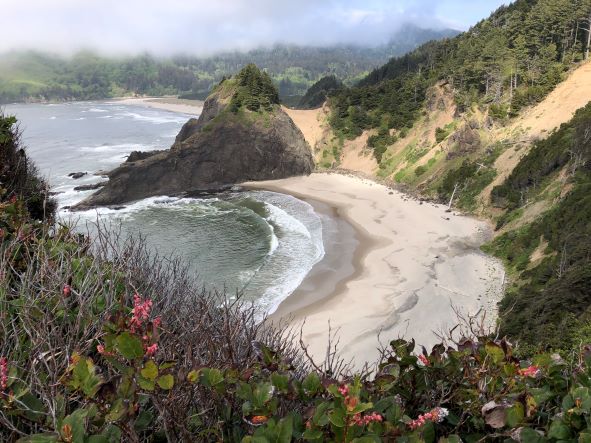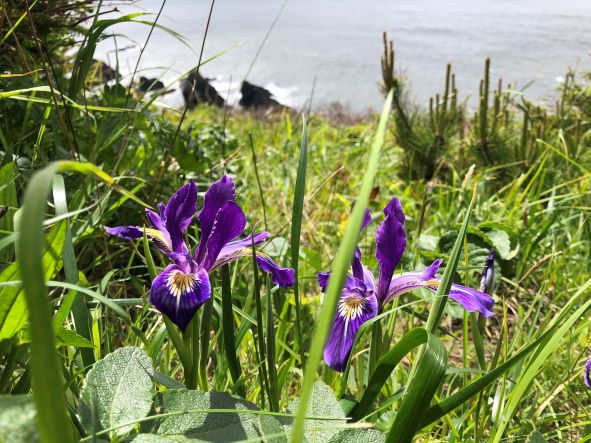
Camp Westwind welcomes everyone, even rare butterflies!
Learn how Camp Westwind and IAE are teaming up to protect one of the last best remaining examples of coastal prairie habitat on the Oregon Coast.
By Celeste Lebo
March 2022
Camp Westwind is located on the central Oregon Coast north of Lincoln City. The 529-acre site provides campers with the chance to explore dunes, forests, marshes, and prairies that once dominated the Oregon Coast. As habitat loss occurred, some animal species declined because they depended on plant communities that were found in the same stretch of coastline that was most easily developed. Coastal prairie is one such plant community that has become rare over the last century. Once common, coastal prairies depend on recurring disturbance to maintain an early seral plant community. Along the coast, the combined effects of shallow soils, maritime climate, proximity to sea spray, blowing sand, and traditional burning practices by local tribes helped preserve the historical extent of coastal prairies.
Loss of prairie habitat has had the greatest impact on the Oregon silverspot butterfly (Speyeria zerene hippolyta). Listed as federally threatened by the U.S. Fish and Wildlife Service, the butterfly once occupied coastal grasslands and prairies from southern Washington to northern California. Extant populations now comprise only five sites, making them vulnerable to extinction due to their small number, small population size, and isolation from one another.
In 2019, Camp Westwind asked IAE to provide an assessment of coastal prairie habitat on their property. Understanding the ecological significance of coastal prairies, Andy Lindberg, Executive Director of Camp Westwind, and the Board of Directors wanted to find out what they could do to help support recovery efforts for the Oregon silverspot butterfly.
Our work at Camp Westwind gave us the chance to study one of the last best examples of coastal prairie habitat on the Oregon Coast: Iris Meadow. Perched on a headland hundreds of feet above the ocean, this remnant headland prairie has substantial native plant diversity, including a healthy population of a rare plant called bristly-stemmed checkermallow (Sidalcea hirtipes). However, invasive species and natural successional processes threaten current meadow conditions. In the coming year, IAE will work with Andy to secure funding to allow the camp to begin implementing restoration actions to protect the coastal prairie community at Iris Meadow and, in turn, the Oregon silverspot butterfly.
We asked Andy what it was like to be part of the Camp Westwind community: “Those who have the honor and pleasure of taking care of Westwind feel the weight of the responsibility. When people visit Westwind, they inevitably connect with the place. For some, it is the beach; for others, it is the river or the forest. On a personal level, some of my first and most affecting experiences in nature happened at Westwind when I was a kid. To now be able to ensure that others can have the same experience is humbling.”
It's projects like Camp Westwind that remind us of what makes the Oregon Coast so special: not just because of unique places like Iris Meadow, but also because of people like Andy and his team at Camp Westwind who understand that land stewardship is all about relationships—the relationships between plants and butterflies, between people and place, and between organizations like Camp Westwind and IAE, doing their best to protect the rarest and most vulnerable species on the Oregon Coast.
Many thanks to the Oregon Watershed Enhancement Board for funding our work at Camp Westwind.
Restoration
Research
Education
Get Involved
Contact
Main Office:
4950 SW Hout Street
Corvallis, OR 97333-9598
541-753-3099
info@appliedeco.org
Southwest Office:
1202 Parkway Dr. Suite B
Santa Fe, NM 87507
(505) 490-4910
swprogram@appliedeco.org
© 2025 Institute for Applied Ecology | Privacy Policy


